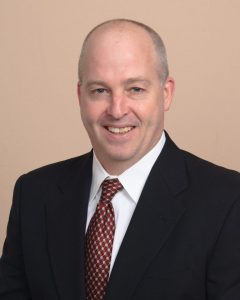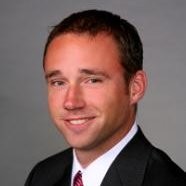 IP Alumni Spotlight: William Cassin
IP Alumni Spotlight: William Cassin
Head of IP for North America at thyssenkrupp North America, Inc.
One day, as you diligently work through engineering design calculations, your manager puts a competitor’s product on your desk and says: “Our competitor’s have product X in the market and we need to make a similar product. Find out if they have a patent on this product, and if so, how can we design around it so we don’t infringe their patent.” If this scenario sounds familiar, your self-guided exploration of the merger of technology and law may have you contemplating a transition into the exciting world of intellectual property legal practice. Loyola’s Alumni Spotlight is pleased to share an interview with William Cassin (’06) about his journey to Loyola University Chicago School of Law and beyond.
William Cassin is Head of IP for North America at thyssenkrupp North America, Inc., a $51.1 billion corporation with 158,000 employees in 79 countries. With headquarters in Essen, Germany, the company’s business operations include five areas: Components Technology, Elevator Technology, Industrial Solutions, Materials Services, and Steel Europe. Mr. Cassin is in his fifth year with thyssenkrupp. Prior to going in-house, he worked as a Patent Attorney in the IP Practice Groups at two of Chicago’s largest general practice legal firms.
What was your background before you went to Loyola?
I have a BS in Mechanical Engineering from the University of Illinois at Urbana-Champaign. I worked as a product development engineer for a company that designed and manufactured network connectivity infrastructure solutions for eight years. My roles included fiber-optic prototype R&D, high-performance data transmission connector design, and end-to-end network system production. I was first exposed to patents by performing infringement analyses of competitor’s products and review of patent application claims.
What initial steps did you take to understand patents?
Provided the opportunity to review patents as a working engineer, I started by searching the web. What constituted claims, what did it mean to “infringe” a patent and how was that determined. I read everything I could find. I began a process of developing educational resources that I have continued over the years. These materials are now a valuable source of information I share with engineers in my current organization. They provide an introductory explanation of patents that I would have found useful when I was in that role.
Was a law degree always part of your plan?
Not at all. I knew a family friend who was a lawyer, but that was the full extent of it. My interest in pursuing a legal education started with reviewing patents as part of my engineering responsibilities. The more I learned about the nuances of patent law, and the more I helped my engineering colleagues design around competitor’s patents, the stronger my interest became.
How did you choose Loyola?
I selected the evening program and continued to work as an engineer. I knew I was interested in practicing patent law, and Loyola offered a very compelling intellectual property program in terms of the course offerings. In addition to classes on IP and Patents, I was able to take a class on Biotech/Pharmaceuticals. I would definitely recommend taking advantage of the broad catalog of options available. Additionally, I especially enjoyed the excellent opportunities Loyola offers in Appellate Advocacy and Pre-Trial Litigation.
What was your experience working at large general practice firms?
Thrilling. Despite the overall number of attorneys at the firm, the full-service IP practice group functioned as a tight knit team. The group consisted of twenty attorneys. I was able to work on a wide range of issues, including patent prosecution, pharmaceutical litigation, merger & acquisition deal work, cease and desist letters for infringement, and trademark clearance, procurement, and protection. With the ability to sample all areas, I was not required to function in a silo.
I discovered that technical writing came very naturally. Inventor interviews were enjoyable and I was able to accurately convert the technical discussions into legal documents.
How did the decision to take an in-house position come about?
Quite unexpectedly. I was very happy in the firm environment. Although I had never sought out an in-house job, I was open to the possibility. A fellow classmate from law school, working as a legal recruiter, contacted me with a position she thought precisely matched my qualifications. The transition permitted additional scheduling flexibility for my family and reduced the number of late nights required. It was the right move at the point I was at in my career.
Can you describe your current responsibilities?
In many ways, I am busier now than I was before. thyssenkrupp is a large German-based multi-national conglomerate that is composed of over 400 separate companies internationally, and about another forty within the North American region alone. The volume and complexity of tasks corresponds with this massive scale. My group handles in-house patent and trademark prosecution, manages outside patent prosecution, conducts IP due diligence, drafts IP licensing and joint development agreements, provides litigation support, leads strategic IP decision making, and provides IP training to thyssenkrupp’s employees across the North American region. The work includes patent applications and office actions on technologies ranging from mining equipment to elevator systems and automobile steering columns. I am fortunate to come in contact with a broad base of technologies.
In my role, I am called upon to wear two hats. I provide legal services as an attorney, but I am now additionally involved in delivering strategic business counsel. I am active in determining the path forward for the company’s IP portfolio, assessing risks, evaluating competitors, and protecting thyssenkrupp’s important assets.
What are some of the unique aspects of working at a multi-national corporation?
The exposure to German and Chinese patent application processes through our foreign colleagues has been a wonderful learning opportunity. For two weeks a year, the global intellectual property team gets together to understand the nuances of intellectual property law in different national jurisdictions, and to continue to try and improve our own internal processes in ways that will work across multiple countries. Just as important as the technical and structural differences, we gain insights into the different IP prosecution strategies, styles, and techniques commonly utilized by our foreign counterparts, and the reasons why each approach is employed.
Any parting words of wisdom for IP orientated law students?
IP and Patents are truly fun. You get the opportunity to be involved with the newest developments and inventions of your clients. And for technology companies, much of their value is derived from the IP they own, making the role of an IP attorney an important one, whether you will be helping to procure patents on new inventions or via acquisitions, enforcing your clients’ patent rights in litigation, or providing counseling on IP strategy and helping development teams minimize infringement risk in new products.
Also, seek out what is new and different. If you get a chance to be around patents, make sure you take a close look. The same advice holds true in selecting courses. Take advantage of the possibilities. Get exposure to as much IP coursework as you can. It will help you start to realize what aspects of IP law truly interest you.
Interviewed by: Ted Mahan, Juris Doctor Candidate 2020. 
Originally posted on 5/2/18 on the Law School Admissions blog.
